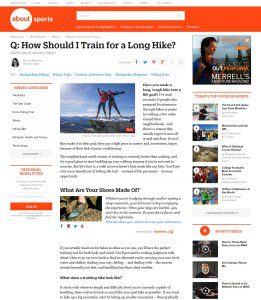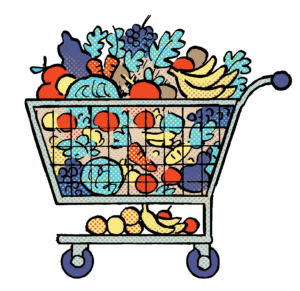 A year-long effort to redesign About.com and ramp up native ad formats forced the publisher to take a hard look at itself.
A year-long effort to redesign About.com and ramp up native ad formats forced the publisher to take a hard look at itself.
On the plus side, there was no dearth of content onsite. “We make 6,000-7,000 new pieces of long form content every month and we have a corpus of over 3.5 million articles,” Neil Vogel, About.com’s CEO explained. About.com also employs 1,000 “experts” to craft content for 90 million readers a month in a dozen channels dedicated to subjects like health, food and home.
But the site was tricky and tough to navigate. “I think what we were notably bad at was giving people a user experience they enjoyed and liked,” Vogel acknowledged. “We had code in our CMS and on our site that was from the nineties.”
Beyond the less-than-stellar user experience, About.com’s marketer offerings were limited by an “old and inflexible platform” that was mostly relegated to standard IAB units, he said, which didn’t necessarily compel brand advertisers to stick around, spend and tell stories.
Thus, when Vogel joined the InterActiveCorp-owned publisher as CEO 18 months ago, he put it on a path to diversify ad units, introduce native formats and scale up programmatic operations by hiring Scott Mulqueen to lead programmatic and audience strategy one year ago.
Vogel and Mulqueen spoke with AdExchanger about the property redesign, About.com’s spin on native, and applying data science to content strategy.
AdExchanger: What has this redesign enabled you to do for advertisers? What’s your pitch around audience?
NEIL VOGEL: We wanted this to allow marketers to tell stories. The reason it’s such a compelling platform is all of our traffic is people who want to do something. They have intent. They want to learn something or fix something. If they want to have a barbeque, we can put a Kingsford Charcoal native ad on that “How to make barbeque sauce” page and it’s an incredibly effective thing for Kingsford Charcoal. It’s contextually relevant and visually relevant because it’s a native execution. Of course it’s table stakes to do IAB and Rising Stars formats, but we also need to be able to do the things marketers want, which is increasingly content marketing and native.
Where are you right now in this process?
NV: Because we have such scale and data, we’ve brought Scott here to do this. We’ve gone from being one of the least sophisticated to being on the path to becoming better and more effective users of programmatic as part of our overall ad stack to enhance our premium programs. We want to [cater to] people who want to buy in certain ways and really use the upper half of the funnel of selling the premium stuff and doing really high value programmatic stuff, which is the future for premium publishers. There’s been a ton of change going on here.
What was the first step in the revamp?
NV: When we got here, we really focused on understanding how our site worked and how our content worked and set out to make something beautiful. At the end of the day, the key thing about helping people is they have to trust you and the way our old site looked did not make people want to trust you. … We have redone the CMS over the last 18 months and redone all the technology that runs under our site to make it really flexible.
We started at the beginning of August rolling out individual channels and last week we completed the whole thing. It’s like somebody turned the lights on. All the metrics are up, which indicates we’re on the right track. People are staying 10% longer, they’re clicking, and they’re engaging in 10% more content than they did last time.
How do you determine the success of a native ad campaign? What metrics do you use?
NV: In the first quarter of this year, 4% of the deals we sold had a native or content marketing component. For the quarter coming up, so far 57% have a native component. Everyone in the market wants to talk about native, but is a promoted tweet in your twitter stream native advertising? I don’t know. It’s native in the way it looks like every other post on Twitter, but is it contextually relevant? That’s harder to say. I get stuff in my Twitter stream that’s definitely not relevant to me. I think our native is based on data. We have a data science group of seven and three of them are PhDs.
What’s the data science team prioritizing?
NV: They’re working on a way to map our 3 million pieces of content to understand the intent of each of the articles. In other words, we know this article is about dogs. We know there’s dog care and dog walking and then there’s an article about hot dogs. When the advertiser sells dog food or dog products, we can create really immersive native units and target everything across our whole network to target “dogs” not just in the pet channel. It can be “running with dogs” in the fitness channel, for example, and what that allows us to do is give people native at scale in an environment where we totally control all the content. That’s been really effective.
How do you know native works? What are you measuring?
NV: Somebody might want sign-ups, clicks or views. It’s one of those things where you fish where the fish are. When you’re a premium publisher, you have the ability to monetize in all kinds of ways. You can do premium brand advertising, and lower-funnel play advertising and CPC stuff. For us, it’s not a conscious decision to move away from CPC advertising because that can be really effective in certain ways on the site. For us, it comes down to a math decision. At the end of the day, will users be more engaged with this ad vs. that ad. Right now, doing real premium display and integrated display is probably the most effective way to keep users engaged and make money. But there’s always a place for CPC ads in what we’re doing.
 If I’m an advertiser interested in native, how do I begin? How do the units get served?
If I’m an advertiser interested in native, how do I begin? How do the units get served?
NV: We have all kinds of formats we can do and we’re actually in the process of trying to figure out what all we can do. We’ve done the traditional, “I’m going to sponsor a channel,” which Volkswagen did with “Home.” We baked in a bunch of native units along with the launch of our Home channel. We did the [outdoor footwear and clothing company] Merrell deal, where they wanted to reach a certain type of user and reader and we used really interesting native units to drive people from [hiking-related] articles to them. Then, we’re building whole custom sections of the site like we’re doing for Disney, that can be much more robust, like integrating a trip-planning function. There’s a market for all of [those things] and I have no idea what we’ll be doing a year from now, but we are trying to empower our team here to talk to marketers and figure out what they want.
Have you invested in creative to accommodate customized formats?
NV: We have a 50-person ad team, 1,000 writers and essentially a creative studio in-house already. When we started, every single unit we sold programmatically was put into an exchange or bought in an open auction. We don’t do anything now in an open, no-floor “buy whatever you want” auction. Scott’s done an incredible job of building a programmatic stack and effort that works really close to premium display and just serves clients who just want to talk to [About.com].
How has programmatic evolved at About.com?
SCOTT MCQUEEN: We built out a fairly robust private marketplace offering that complements all of the high-touch, native sponsorship, big bang stuff that we can run on the direct display side. It makes sense at [our] scale to play in multiple layers on marketers’ budgets, which obviously benefits us revenue-wise, and benefits marketers because they can come to us more as a one-stop shop as opposed to just a piecemeal partner for them. From that perspective, it’s worked out really well. [We not only allow buyers to] bring their own data to the table, [but] at the end of last year, we partnered with a tech provider to build out our internal DMP, which has all the data Neil was referencing earlier and allows us to look horizontally across the site and find users in pockets of the site you never thought existed or never would have considered. From a marketer’s perspective, if the timing of seeing those users and serving them an ad is right, we allow them to do that.
Are you partnering with Rubicon or PubMatic as your sell-side platform?
SM: As our stack evolves, we’re working selectively with people who can help us. We do lean on those tech companies you identified – some more heavily than others. As you’re aware of, this space is a constantly evolving assessment of partnerships. Some may have ecommerce strength, some may have developed a product that makes more sense for a publisher and if that is the next-best place for us to be in, that’ll be who we hook up with.
Are you staffing up on your programmatic sales team?
NV: Scott’s team is currently four people, but that implies that he’s off on an island somewhere, which he’s not. (Programmatic is) part of the larger sales team. Our whole sales team, including sales support and all the various functions, is about 50. The actual sellers, that’s about 19. Of those 19 sellers, 12 are new since we got here. We had to reinvent what we were doing and brought in some great talent to do so (including CRO Brian Colbert, former VP of mobile ad sales at Pandora).
Who do you compete with? Is it a vertical-interest site like Demand Media’s eHow.com?
NV: Those guys did something really different from us. I can’t speak for them because I didn’t work there, but the whole idea was to get on Google and get traffic. That’s not what we do. What we do is identify areas of interest using both editorial people and lots of data that’s on the Internet. We try to find the very best person we can to write about that and they go very deep on their topic of interest. Because these people are really talented in their area of expertise, it turns out Google really likes our stuff because we’re not trying to find a gap in the Google algorithm.
Our content is made by a professional writer to really help people solve problems. In food, we compete with Epicurious. In health, we compete with WebMD and Everyday Health. That’s who we sit on a search results page with. We’ve never been a vertical Q&A site. We’ve always been more of a big premium publisher with lots of articles. One of the challenges of our redesign is how do we make our food site look like a food site and a health site look like a health site – competing with guys doing premium stuff in each vertical.














